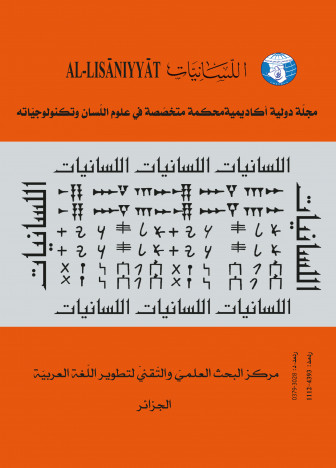مقاربة اتصالية للمعالجة الآلية للبنى النحوية في اللغة العربية على أساس الشكلانية الخليلية الجديدة
##plugins.themes.bootstrap3.article.main##
الملخص
تحاول التقنيات التي تستعمل شبكات الخلايا العصبية الاصطناعية تقليد هيكل الجهاز العصبي لاستخلاص المزايا المتعلقة أساسا بقدرات التعلم والتعميم، والمتانة، والقدرة على مواجهة الخلل، والقدرة على العلاج المتوازي.
وهذه الدراسة تدخل في إطار تطوير نظام مبني على شبكة الخلايا العصبية الاصطناعية لتحليل البنى التركيبية القائمة على النظرية الخليلية الحديثة، وذلك في الميدان المتعدد التخصصات للعلوم المعرفية حيث أنها تدمج التمثيل الرياضي، والتقنيات الإعلامية للعلاج الصوري للغة الطبيعية، وأسس النظرية اللسانية.
يتكون نظام « Neurokhall » من شبكة الخلايا العصبية المتراجعة إلى الوراء بطريقة بسيطة مركبة مع نظام RAAM (Recursive Auto Associative Memory) لعلاج البنى التركيبية المعقدة التي لها صفة الإطالة. ويمكن، في هذا النظام، إدخال الجملة كلمة بكلمة على شكل صفات تركيبية ليقدم في الأخير أصناف البنية التركيبية كما حددتها النظرية الخليلية الحديثة.
##plugins.themes.bootstrap3.article.details##
المراجع
__________, A Connectionist Parser with Recursive Sentence Structure and Lexical Disambiguation, AAAI – 92 Americain association for Artificial Intelligence, pp. 32-37, 1992.
Blair Alan D., Scalinhg-up RAAMs, Département informatique, université de Bandeis, janvier 1997.
Chafe Wallace, Meaning and the Structure of the Language, University Press Chicago, 1970.
Chan Samuel W.K. and Franklin James, A Neural Network Model for Acquisition of Semantic Structures, International Symposium on Speech Image Processing and Neural Networks, Hong Kong, pp. 221-224, 1994.
McClelland J.L., Mark st Jhon and Roman Taraban, « Sentence Comprehension : A Parallel Distributed Processing Approach », Language and Cognitive Processes, pp. 287- 335, 1989.
Elman Jeffrey L., « Finding Structure in Time », cognitive science, 14, pp. 179-211, 1990.
_____________, Distributed Representations, Simple Recurrent Networks, and Grammatical Structure, département des sciences cognitives et de linguistique, 1991.
Fodor.J and Pylyshyn.Z, « Connectionism and Cognitive Architecture : A Critical Analysis », in Connections and symbols, pp. 3-71, Cambridge MIT Press, 1988.
Hadj Salah Abderrahmane, Linguistique arabe et linguistique générale : Essai de méthodologie et d'épistémologie du ‘ilm al-‘Arabiyya, thèse de doctorat, Paris Sorbonne, Vol. 2, 1979.
Jain Jianchang Anil K. Mao K. Mohiuddin, Artificial Neural Networks : A Tutorial, IEEE Computer Special Issue on Neural Computing, mars 1996.
Koong H.C. Lin and Tung-Bo Chen and Von-Wun Soo, « Neural Network Learning and Encoding of Thematic Role Assignments in Parsing of Simple Chinese Sentences », Journal of Information Science and Engineering, vol.11, n° 1, pp.109-126,1995.
Meftouh Karima, Une approche connexionniste pour la génération d’une représentation interne du sens d’une phrase basée sur les cas sémantiques appliquée à la langue arabe, mémoire de Magistère, université de Annaba, 2000.
Miikkulainen Risto Michael G. Dyer, Natural Language Processing with Modular PDP Network and Distributed Lexicon, cognitive science, 1991.
Pollack Jordan B., Recursive Distributed Representation, Laboratoire de recherche en intelligence artificielle, université de l'état de l'Ohio, 1990.
Rumelhart De. and Hinton Wiliam, « Learning Internal Representations by Error Propagation », Explorations in the microstructure of cognition, Vol 1, pp. 318-362, Cambridge MIT Press, 1986.
Shephard GM, Synaptic organisation of the brain network, Oxford University Press, 1990.
